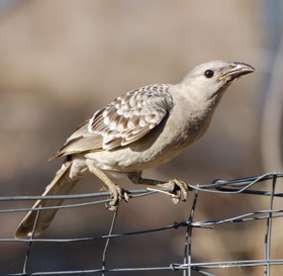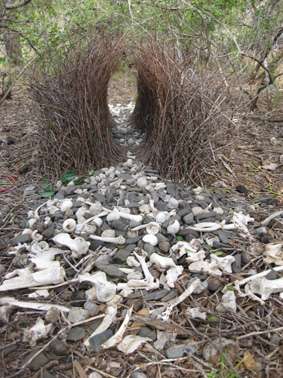Males stick to their individual style for luring the ladies, regardless of success rate

(Phys.org)—Males have their own distinct repertoire for attracting females and stick with it regardless of how successful they are; at least that's what Deakin University researchers have found with the great bowerbird.
The researchers with Deakin's Centre for Integrative Ecology, Alfred Deakin Professor John Endler and Dr Laura Kelley, have been studying the mating habits of the great bowerbird. Their focus has been on the importance of the visual illusions the birds create within their bowers in attracting females and ultimate mating success. (Bowers consist of a tunnel of sticks leading to a court area decorated with stones, shells and bones built specifically for mating purposes.)
Their recent findings, published in the prestigious Proceedings of the National Academy of Sciences, show that while the male great bowerbird might be a master of visual trickery when it comes to luring females into their bower, they have a distinct way of decorating that they rigidly stick with, regardless of how successful they are at attracting mates.
"We know from our previous research that the quality of the visual illusion the males create with the objects in their bowers predicts their likelihood of attracting a mate," Professor Endler explained.
"We now know that each bird has a preferred approach that they stick too, even if that approach is not attractive to females, and regardless of the help we gave them in improving the quality of their display."
The key to mating success for the bowerbird lies in the quality of the optical illusion, or forced perspective, created by the way objects are placed in the court area of the bower. Objects are placed within the court to create a scene that only works from the female's viewing angle. Smaller objects are put closer to the female's view and larger objects further away, creating the forced perspective or illusion that anything within the court is larger than it really is. The males that construct courts that look evenly patterned to the female attract the most mates.
Despite efforts on the part of the researchers to improve the quality of the bower display, and therefore improve the bird's chances of attracting a mate, the bowerbird would rearrange the display back to the original form.
"They have their preferred approach and won't budge on this even if the new design is more attractive to potential mates," Professor Endler said.

"We improved the quality of the forced perspective to see if the males maintained the display at the new higher level, decreased the perspective quality back to its original quality, or allowed it to decay at random over time. We found that the original perspective was actively recovered to individual original values within three days."
Professor Endler finds it curious that the birds preferred their mediocre efforts over the researchers' improvements.
"The really interesting aspect is that they prefer inferior illusions (compared to what they can do) and that some males are considerably better than others.
"This is relevant to arguments amongst evolutionary biologists about honest advertising of male quality when it comes to mating. What makes males do worse than they could do? We cannot think of any cost, which is supposed to limit indicators of male quality. All of the cost for the bowerbird is in bringing the objects to the bower; once that is done it is just a matter of rearranging them. So why make a good arrangement worse by returning it to the previous value when females prefer the better ones, so why don't they keep the improved arrangements that we made?
"It is a curious situation, and one that I hope to find answers to in the future."
More about the study and great bowerbird
The great bowerbird (Ptilonorhynchus nuchalis) is found in northern parts of Australia and, as with all bowerbirds, is well-known for the large and elaborately decorated bowers the males construct to attract females.
The bird's bower consists of a 60 centimetre long tunnel-like avenue made of sticks that leads to a court area decorated with stones, shells and bones. As part of the mating ritual, the female stands in the avenue to watch the male put on a show in the court; he flashes his purple crest and waves coloured objects to entice the female to mate.
Previous studies by the Deakin researchers found that male great bowerbirds use an optical illusion known as forced perspective to construct their bowers. The scene created only works from the female's viewing angle and could trick her by altering her perception of the male's display. They also found that the quality of the illusion ultimately predicts mating success.
The forced perspective within the bower is generated by a gradient of court object sizes where smaller objects are placed closer to where the female is watching within the avenue and larger objects are further away, all within her field of view. This gives the female a view of an even textured pattern which may make the male's displays easier to see, possibly make the court appear smaller, and may induce further optical illusions.
For the current study, the researchers measured the forced perspective over the course of one breeding season and compared the forced perspective of individual males between two successive breeding seasons.
After improving the gradient of 25 bowers, the birds returned their courts to the original state within three days. Individuals varied significantly in their court parameters and these were consistent during the course of the breeding season and between two breeding seasons, indicating that great bowerbirds consistently vary in their ability or tendency to make gradients and therefore forced perspective.
These results demonstrate that males maintain characteristic illusions even when they have the materials available to produce better ones.
More information: www.pnas.org/content/early/201 … /1208350109.abstract
Journal information: Proceedings of the National Academy of Sciences
Provided by Deakin University


















